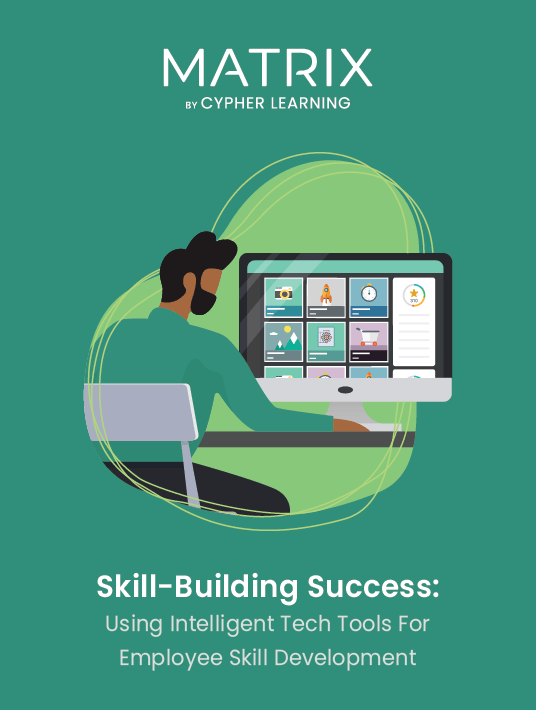Intelligent Learning Platform Features To Look For
Which Intelligent Learning Platform Features Should You Consider?
Drawing a line between LMS and LXP isn’t necessary or useful. On the contrary, companies can have the best of both worlds, meaning LMS and LXP features merged into a single one: the intelligent learning platform (ILP).
The ILP is a game-changer for skill development since it has Artificial Intelligence (AI)-based features that enable a more personalized training experience based on skill development and attaining career goals.

eBook Release
Skill-Building Success: Using Intelligent Tech Tools For Employee Skill Development
Let’s explore how to design effective skills development strategies in any organization with the help of the latest learning technologies!
8 Essential Features Of An Intelligent Learning Platform
Adaptive Learning
Adaptive learning, as the name suggests, accommodates the employees’ needs and helps personalize their learning experiences dynamically. How? Based on the previous actions that employees have taken on the platform. For example, learner A has more years of experience and demonstrates a higher skill level than learner B. Both learners take the same course or are enrolled in the same learning path but see completely different modules and assessments.
Adaptive learning is also a convenient way for employees to focus on upgrading their skill level by only showing them the training sections that will help them do so.
Automation
Automation is the thread that connects different aspects of the platform, including enrollments, inactivity actions, assessments, gamification, and even social learning features such as employee groups. Automation is the most basic and essential part of an ILP. It works through “if-then” rules such as “If learners enroll in a course, then they automatically receive a custom welcome message” or “If learners get a score of more than 80%, then they are enrolled in a more advanced skill development module.”
Consequently, the platform takes care of the most time-consuming and tedious tasks, so L&D and HR staff have the opportunity to manage their workload better and work on more creative aspects of training development.
Gamification
Adding gamification elements [1] to a skill development course helps motivate employees to stay on track and complete their training. Since gamification is powered by automation, learners instantly receive badges, points and other rewards, so they feel a sense of accomplishment after completing a module or a quiz. Gamification is more than displaying earned badges on learner profiles and featuring the top trainee performers on a leaderboard. It’s a fun measure of learner progress in their skill development journeys.
Learning Goals
Learning goals are an excellent addition to skill development training. This feature allows employees to focus on achieving competency-related objectives such as “I want to learn advanced graphic design skills.” Alternatively, employees can also focus on achieving a particular job and its associated competencies, such as “I want to become a Senior Graphic Designer.” Learning goals are a good way for learners to pursue the opportunities that their company may offer. Employees don’t have to wait for organizational or economic shifts before upgrading their skills.
Automated Recommendations
Automated recommendations are based on learning goals. For example, if an employee wants to become a Senior Graphic Designer, they can choose their goal, and the platform will automatically suggest relevant training content. In this way, recommendations are personalized to fit each individual’s aspirations and show various learning options. For instance, an employee can enroll in an online course, join a learning group, watch a tutorial video, read an article or contact a potential mentor to enhance their skills and close learning gaps.
Third-Party Training Partners
An ILP allows companies to create a learning ecosystem that supports and sustains skill development. On the one hand, in a closed ecosystem, only some employees have access to training. This means that inter-departmental communication is weak and innovation is stifled. On the other hand, a healthy ecosystem is open and connected. Each member has the right professional development opportunities.
Access to third-party training content such as LinkedIn Learning or Go1 is essential for a healthy ecosystem. In this way, instructors don’t have to create all skill development courses, and the diversity of training materials covers most employee needs.
Community Building
In a global organization, building a learning community is challenging. Employees often work in different time zones and don’t have as much contact as needed to learn together. A learning platform that allows asynchronous discussions is a good starting point to get them excited about sharing their knowledge. However, a community-building effort is sustained by bringing together employees with similar learning goals that communicate with the help of various tools, including groups, private messages, chats, and forums.
Mentorship Opportunities
Creating a good mentorship program [2] means less experienced employees can advance their skills with the help of their peers. At the same time, more experienced ones are also recognized as important members of the organization. In an ILP, mentors are learners who have already completed their goals. The platform can suggest other employees contact them and ask for help in achieving their desired skill levels. Most importantly, it’s a way to pair novices and mentors, so training specialists don’t have to do this manually or “nudge” learners to collaborate.
Key Takeaways
Skill-building success depends on the quality of the training platform companies have at their disposal. An ILP offers the best skill development features, so companies don’t have to choose between functionality and learning journey optimization. Instead, it provides both LMS and LXP features and uses AI to eliminate tedious administrative tasks, including training recommendations.
Download the eBook Skill-Building Success: Using Intelligent Tech Tools For Employee Skill Development to learn how you can use modern technology to fuel employee growth. You can also join the webinar to discover how to create effective skill development programs for employees.
References
[1] Gamification Of Adult Learning
[2] How to create the best mentorship program for remote employees


